Meeting minutes generation with ChatGPT 4 API, Google Meet, Google Drive & Docs APIs


Your meeting minutes generated automatically in a document with ChatGPT right after recording your meeting
1. Unleash the Power of ChatGPT to Do (Useful) Things
In this technical article, we will explore how to leverage the ChatGPT 4 API along with Google Meet, Google Drive, and Google Docs APIs to automatically generate meeting minutes.
Taking minutes during a meeting can be a time-consuming task, and it is often difficult to capture everything that is discussed. With the use of artificial intelligence, the process can be streamlined to ensure that nothing is missed.
As Microsoft Teams or Zoom, Google Meet has the ability to record meetings. Once the recording is activated, the transcript of the meeting is generated in a Google Document format and is stored on a defined Google Drive shared folder. Google Meet transcript file is used here but similar transcript text extract could also be done with Teams or Zoom recording.
For this, a simple web application will be used as a central point to manage the user interaction as well as the different API calls. The purpose is to display a list of these meeting transcript documents stored on a predefined Google Drive folder. The user will be able to select one of them then press a button to generate a summary of the meeting minutes as well as the action items with due dates. Also, these two new sections will be inserted in the same Google Document with Google Docs API, containing the results from ChatGPT API.
This article will walk you through the steps required to set up the necessary configuration and to understand the Dash/Python application code used to manage the ChatGPT, Google Drive & Docs APIs.
A link to my GitLab containing the full Python/Dash source code is also available on the next sections.
By the end of this article, I’ll also share my thoughts on some limitations and improvements that could be done on this application. I hope it will allow you to find new ideas on how to stay focused on more valuable tasks than taking meeting minutes.
So let’s dive in!

2. Overview of the web application capabilities
The web application looks like the screen below. The upper section displays a list of transcript documents present on the user’s shared Google Drive folder. Such documents are automatically generated in the ‘Meet Recordings’ folder when the user triggers the Google Meet recording button.
The user can select a document in the list. The selected document is displayed in the central part. Finally, the user can press the button to generate the meeting minutes.
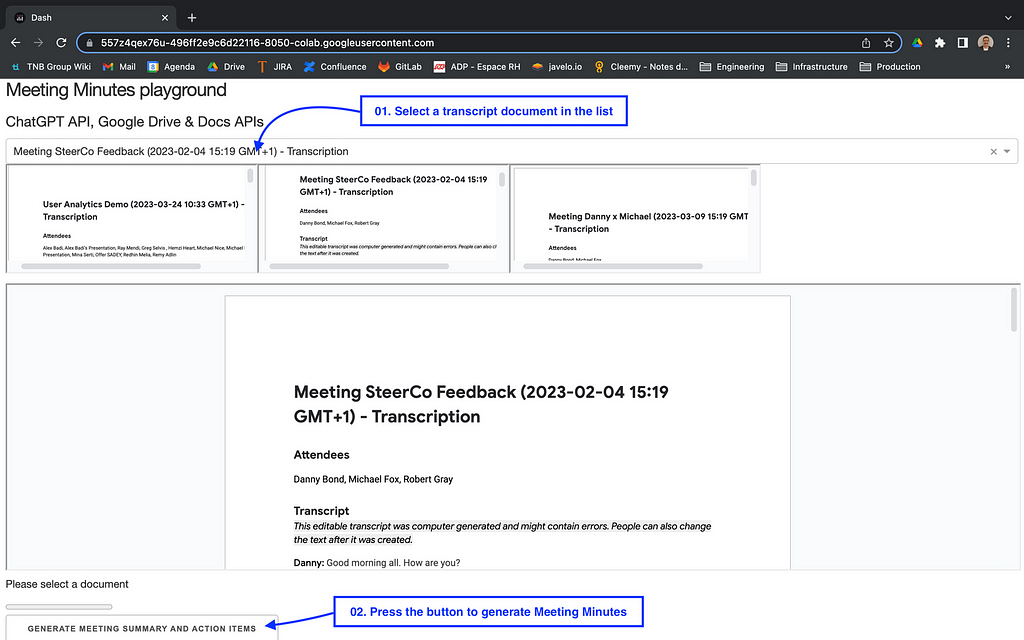
Once the button pressed, the Meeting minutes are automatically inserted in 2 new sections:
The ‘Meeting Summary’ section is a short description of the meeting based on the meeting transcript. It will stay synthetic whatever the duration of the meeting.
The ‘Meeting Action Items’ section is a numbered action items checkbox list which is also based on the transcript. When known, a due date is also inserted.

Each numbered meeting action item contains a checkbox that is natively supported by Google Docs. They could be used later on by your teams to follow up the action list and to check them once they are done.
3. Quick Start
The following will allow you to edit and run the code present on my GitLab. Before doing that, you’ll need to register at OpenAI to get your API key. Also, Google Drive and Docs APIs need to be activated on the Google console, as well as creating a Google Service Account.
- Go to the OpenAI website and sign up to get your API Key
- Go to my GitLab project named Meeting Minutes generation with ChatGPT
- Edit the Jupyter Python notebook with Google Colab and save it on your own Colab folder
- Replace the ‘OPENAI_API_KEY’ value in the code with your own api key
- Use the following link to activate the Google Drive & the Google Doc APIs
- Use the following link to create a Google Service Account
- Download and save the Google Service Account Key (JSon File) in your Colab folder. Name it ‘credentials_serviceaccount.json’ (or change the value in the code)
- Share your ‘Meet Recordings’ Google Drive folder with the Google Service Account created previously (with ‘Editor’ permission)
- Attend a Google Meet meeting. Record it with the transcript. The video file and the transcript document will automatically be generated in your ‘Meet Recordings’ Google Drive folder
- In the code, replace the ‘GOOGLE_MEET_RECORDING_FOLDER’ value with the ID of your ‘Meet Recordings’ Google Drive folder shared previously
- Select ‘Run All’ in the ‘Execution’ menu
- A WebApp should start in a few seconds. Click on the URL generated in the bottom of the Colab notebook to display it
The application should look like the first screenshot in the previous section.
4. Understand the main parts of the code
As of today, the ChatGPT 4 API is still in beta. The used version in the code is ‘gpt-4–0314’ snapshot. It can also be switched to the current version, ‘gpt-3.5-turbo’.
I’ll focus only on the most important pieces of the code.
4.1. Google Drive integration / API
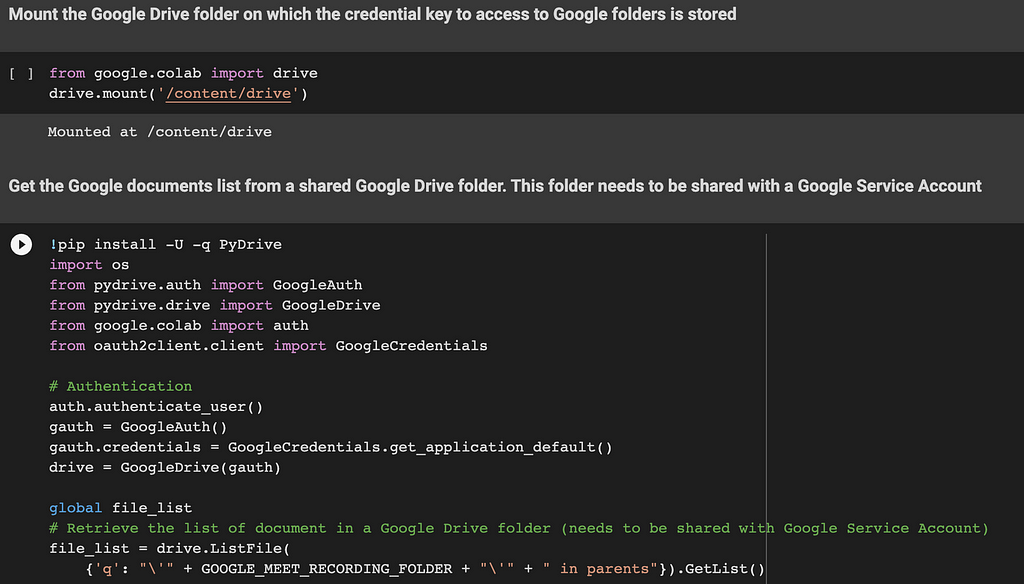
The first two lines of code are used to mount your Google Drive root folder. The main usage is to retrieve the Google Service Account credential key (JSon file) generated within the Quick Start section.
The code of the next section retrieves a file list of all transcript documents stored in the Google Meet Recording folder. The list will be used later to display these documents on the web application.
4.2. Google Meet transcript document text extract
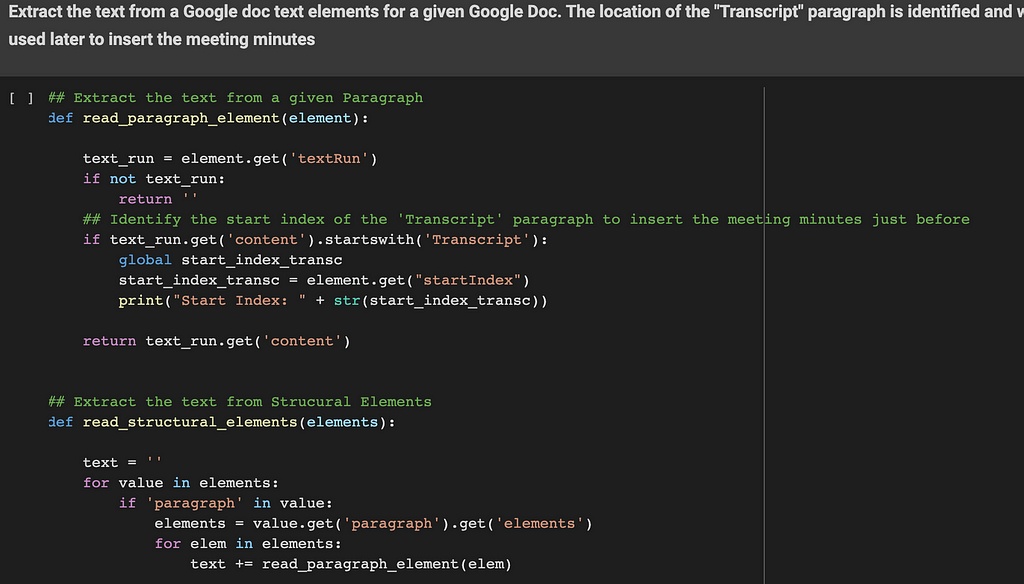
These functions are used to extract text elements from a defined Google Document ID. Google Meet generates a paragraph named ‘Transcript’. The location of the ‘Transcript’ section is identified and will be used later as a starting point to insert the meeting minutes. The two sections inserted by the application will be located just before this ‘Transcript’ section. (and right after the ‘Attendees’ section)
4.3. ChatGPT preparation: break down of the transcript text into chunks
ChatGPT API models have a limited number of tokens per request. In order to stay compatible with the ‘gpt-3.5-turbo’ model, the max value used in the code is 4096 tokens per request. But keep in mind that the ‘gpt-4’ model can handle much more. A 8k or a 32k models are also available, they can be used to significantly improve the meeting minutes’ quality for long meetings.
As a consequence, the Google Meet Transcript document text needs to be broken down into chunks of 4000 tokens with an overlap of 100 tokens.
These functions will prepare and return a list of chunks that will be used later by the ChatGPT API.
4.4. ChatGPT API usage
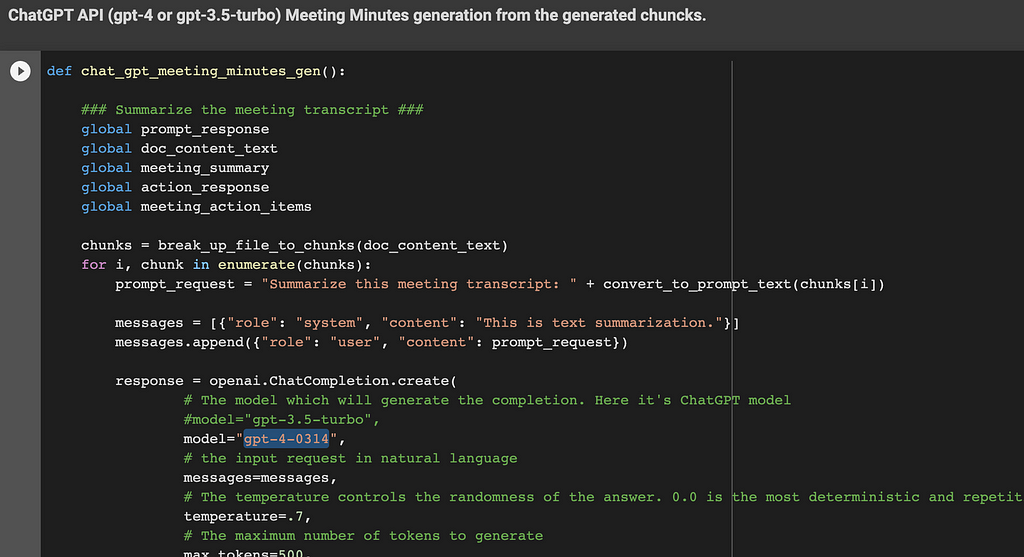
This function generates the meeting summary and action items in a few steps. A ChatGPT API call is done for each of them:
- Step 1: Summarize the meeting transcript text. The function iterates over the chunk list generated previously. The content sent to ChatGPT is based on the recorded conversation between the attendees. The ChatGPT API is called for each chunk with the following request: ‘Summarize this meeting transcript: <chunk>’
- Step 2: Consolidate the response (Meeting summary) from Step 1. The ChatGPT API is called with the following request: ‘Consolidate these meeting summaries: <ChatGPT responses from Step 1>’
- Step 3: Get action items with due dates from the transcript. The function iterates over the chunk list generated previously. The ChatGPT API is called for each chunk with the following request: ‘Provide a list of action items with a due date from the provided meeting transcript text: <chunk>’
- Step 4: Consolidate the meeting action items from Step 3 in a concise numbered list. The ChatGPT API is called with the following request: ‘Consolidate these meeting action items with a concise numbered list: <ChatGPT responses from Step 3>’
Each ChatGPT API used parameter (i.e. ‘temperature’) is documented in the code.
4.5. Google Docs API management usage to insert the final meeting minutes

The objective of this function is to insert the meeting minutes into the Google Doc selected by the user. The text is inserted before the ‘Transcript’ paragraph. The start index identified in the previous functions is used here as a starting point.
Two sections are inserted here: ‘Meeting Summary’ and ‘Meeting Action items’.
Each section’s insertion is done with the following steps:
- the section’s title is inserted (as a text i.e. ‘Meeting Summary’)
- its style is set to ‘HEADING_1’, its text style is set to ‘bold’, its font size is set to ‘14’
- the section’s content is inserted (this comes from the ChatGPT API result)
- its style is set to ‘NORMAL’. A bullet point is also inserted with an arrow for the ‘Meeting Summary’ section and a checkbox for the ‘Meeting Action items’ section
Some ‘tabulation’ and ‘new line’ characters are also inserted to correct the text returned from the ChatGPT API.
Tip: Please note that the ‘ar’ table is iterated in a reversed way to ensure the start index position stays always up to date following each text insertion.
4.6. The main Python Dash Web Application
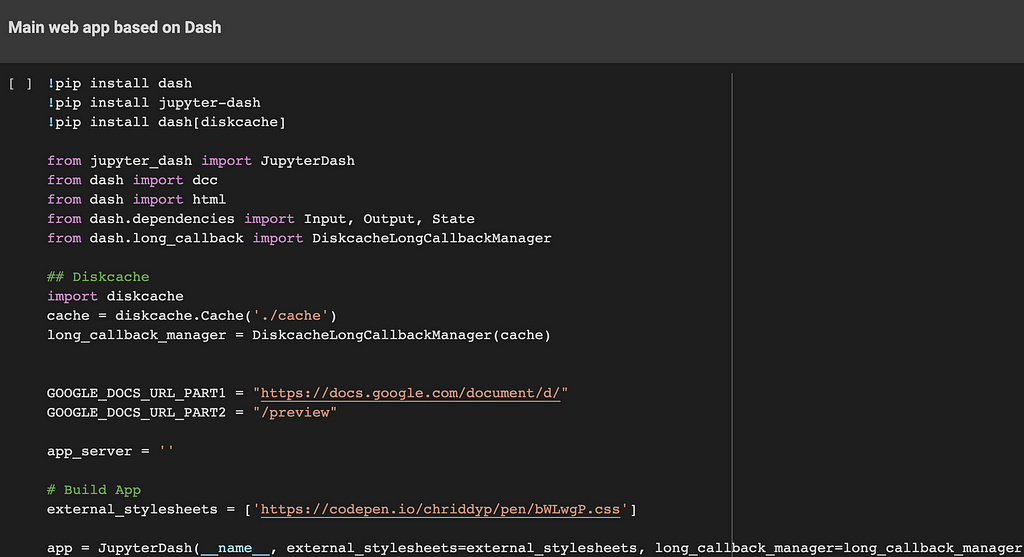
This part is used to build a simple web application on which the user can interact. Basically, it displays a list of documents stored on a Google Drive shared folder. The user can select one of them which is displayed in the central part of the screen. Once the button is pressed, the meeting minutes are inserted into this document. The updated document is refreshed with the results.
This code is built on top of the Dash framework. It even works within a Google Colab notebook.
Each document is displayed within a dedicated iFrame. The document’s link is based on ‘embedLink’ value, previously retrieved by the Google Drive API.
Also, a progress bar is displayed during the ChatGPT API calls and the Google Doc meeting minutes’ insertion steps.
5. Possible improvements
The main challenge using ChatGPT within your company is to have a leak of sensitive information your company is working on. This happened recently at Samsung where employees have accidentally leaked company secrets with ChatGPT.
One of the improvements of this code could be the execution of data masking before calling the ChatGPT API. At least the attendee names and additional tagged fields containing sensitive information should be masked. The meeting name could also contain some tags for data masking. I.e ‘Meeting with <Microsoft>’ where ‘Microsoft’ will be masked on the entire transcript document data extract. Once the response is received from ChatGPT API, the reverse needs to be done. Each masked information needs to be unmasked before calling the Google Docs API.
For this, a reference table needs to be used to store each field ID with its clear and its masked value. So these fields could be masked before calling the ChatGPT API, then unmasked when inserting the meeting minutes’ sections with Google Docs API.
6. The Final Word
Thank you for reading my article to the end, hope you enjoyed it!
As you can see, ChatGPT 4 API combined with Google Drive/Docs APIs are very powerful and can contribute significantly to improving your day-to-day work.
You can find the entire source code on my GitLab: Meeting Minutes generation with ChatGPT

Meeting minutes generation with ChatGPT 4 API, Google Meet, Google Drive & Docs APIs was originally published in Becoming Human: Artificial Intelligence Magazine on Medium, where people are continuing the conversation by highlighting and responding to this story.
AI in Healthcare — Innovative use cases & Applications
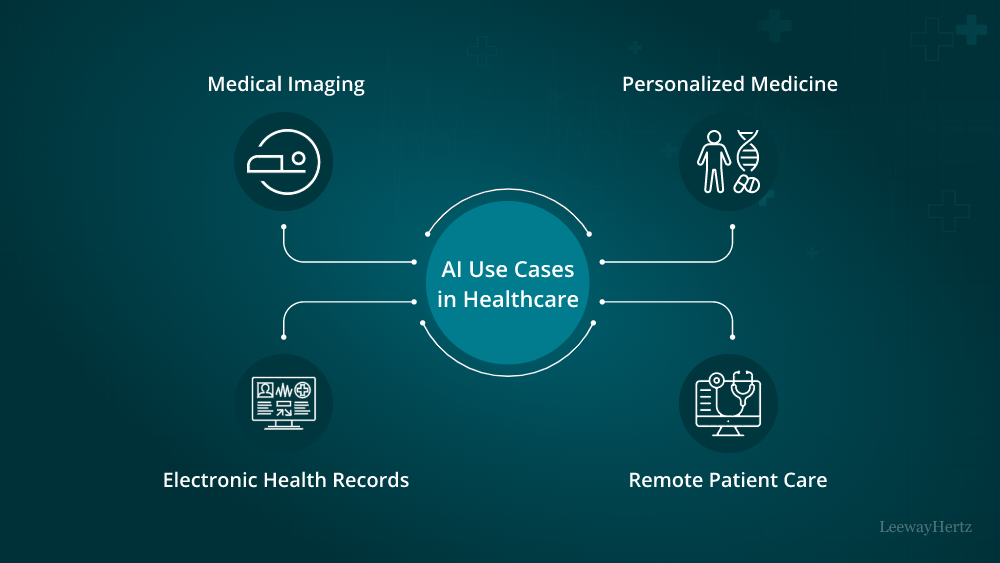
AI in Healthcare — Innovative use cases & Applications
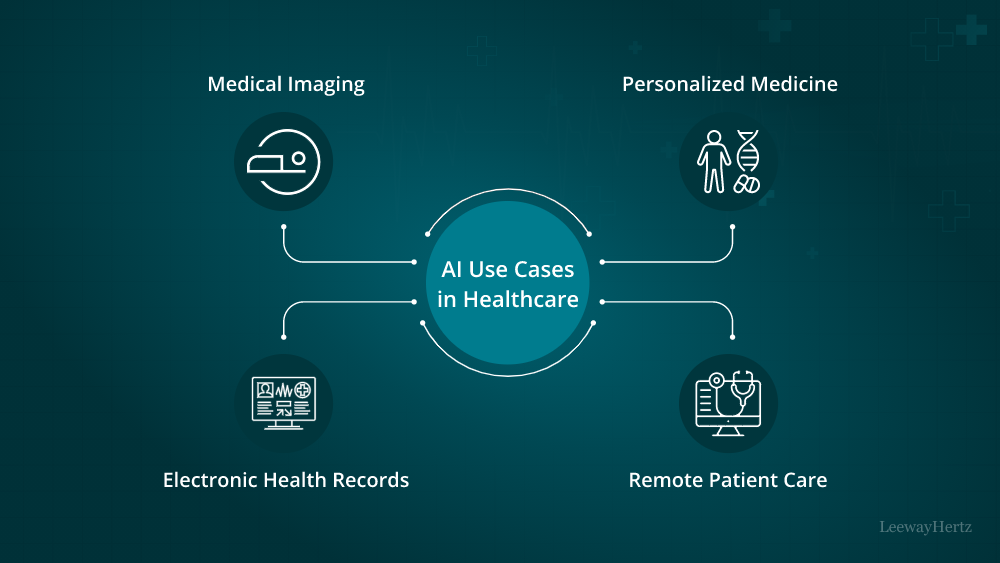
Artificial Intelligence (AI) has emerged as a groundbreaking technology transforming numerous industries, and healthcare is no exception. AI is transforming the healthcare landscape with its ability to process vast amounts of data, recognize patterns, and make intelligent predictions. From diagnosis and treatment to research and patient care, AI has the potential to improve efficiency, accuracy, and outcomes in the healthcare sector.
Artificial intelligence (AI) has significantly impacted the healthcare industry, transforming healthcare delivery and monitoring. AI technology has improved healthcare outcomes by providing accurate diagnoses and personalized treatments. It can quickly analyze vast clinical documentation, identify disease markers and trends, and predict outcomes from electronic health records. The potential applications of AI in healthcare are broad and far-reaching, from early detection to predicting outcomes. With the help of AI, healthcare systems can become smarter, faster, and more efficient, making quality care more accessible to millions worldwide while reducing costs and improving health outcomes.
AI in healthcare plays a crucial role by augmenting the capabilities of medical professionals, enabling faster and more accurate diagnoses, providing personalized treatment plans, and enhancing patient care. By leveraging machine learning algorithms and advanced analytics, AI can analyze complex medical data, identify trends, and generate actionable insights. This empowers healthcare providers to make more informed decisions, optimize workflows, and deliver better patient outcomes.

Benefits of AI in Healthcare
AI in healthcare industry is transforming how we deliver and receive medical care. Some key benefits of AI in healthcare include:
Improved Diagnosis and Treatment: AI algorithms can analyze medical data such as images, patient records, and symptoms to assist healthcare professionals in making accurate diagnoses and suggesting appropriate treatment plans, leading to improved patient outcomes.
Enhanced Precision and Personalization: AI enables personalized healthcare by considering individual patient characteristics, genetics, and medical history, allowing for tailored treatment plans and precise medical approaches.
Efficient Workflow Optimization: AI automates routine administrative tasks, streamlines healthcare processes, and optimizes resource allocation, saving time and reducing costs for healthcare providers, ultimately leading to more efficient and effective care delivery.
Improved Patient Safety: AI systems can help identify potential risks, errors, and adverse events in real time, enabling proactive interventions and ensuring patient safety through enhanced monitoring and predictive analytics.
Advancements in Drug Discovery and Development: AI techniques such as machine learning and data analysis can accelerate the discovery of new drugs, identify drug targets, and optimize clinical trials, leading to faster and more efficient drug development processes.
Research and Insights: AI tools can analyze large and complex healthcare datasets, uncover patterns, and generate valuable insights for researchers, contributing to advancements in medical research, disease prevention, and public health strategies
The Impact of AI on Healthcare
The impact of AI on healthcare has been significant and transformative. By analyzing large amounts of medical data, AI has enabled healthcare providers to make more accurate and timely diagnoses. It has also helped develop personalized treatment plans tailored to the unique needs of individual patients. AI-powered predictive analytics has helped identify high-risk patients and prevent disease before it becomes severe. AI in healthcare has transformed drug development, making it faster and more cost-effective. The rise of telemedicine has been made possible by AI, helping patients access care remotely. It improves diagnostic accuracy, optimizes workflows, enables personalized treatments, accelerates drug development, enhances remote monitoring, and empowers patients. AI can revolutionize healthcare, improving patient outcomes, reducing costs, and creating a more efficient and accessible healthcare system.
Use cases and applications of AI in healthcare
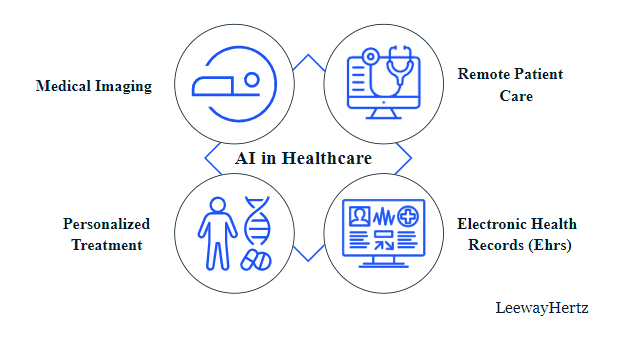
AI use cases applications in healthcare include:
Diagnostics and medical imaging: AI algorithms can analyze medical images such as X-rays, MRIs, and CT scans, assisting in the early detection and accurate diagnosis of diseases like cancer, cardiovascular conditions, and neurological disorders. This reduces human error, speeds up the diagnostic process, and improves patient outcomes.
Precision medicine: AI can analyze a patient’s genetic information, medical history, lifestyle factors, and other relevant data to develop personalized treatment plans. By considering individual variations, AI helps healthcare professionals deliver targeted therapies, predict drug responses, and optimize treatment outcomes.
Virtual assistants and chatbots: AI-powered virtual assistants and chatbots can provide 24/7 support, answering common patient questions based on symptoms. They help alleviate the burden on healthcare providers, enhance patient engagement, and provide immediate access to information and support.
Predictive analytics and early warning systems: AI algorithms can analyze patient data, including vital signs, electronic health records, and wearable sensor data, to predict and detect early signs of deterioration. This allows healthcare providers to intervene proactively, potentially preventing adverse events and monitoring patients’ health.
Robot-Assisted Surgery: AI-powered robots can assist surgeons during complex procedures, providing greater precision, stability, and control. These robots can enhance surgical outcomes, minimize invasiveness, and reduce recovery times.
Health Monitoring and Wearable Devices: AI can analyze data from wearable devices, such as smartwatches and fitness trackers, to monitor patient health continuously. This enables early detection of abnormalities, remote patient monitoring, and prompt intervention.
Drug discovery: AI can help accelerate drug discovery by predicting the efficacy of new drug compounds and identifying potential side effects.
Conclusion
AI in healthcare is transforming various aspects of medical practice. By leveraging its analytical power and pattern recognition capabilities, AI enables more accurate diagnoses, personalized treatments, efficient workflows, and improved patient care. As AI advances, it holds tremendous potential to impact healthcare outcomes positively. The applications of AI in healthcare are already evident in various areas, such as improved diagnostic accuracy, personalized treatment plans, streamlined workflows, and remote patient monitoring. AI algorithms are assisting healthcare professionals in making more accurate diagnoses, optimizing treatment decisions, and predicting patient outcomes. This improves patient safety and outcomes and enhances healthcare delivery efficiency, allowing providers to allocate resources more effectively and focus on delivering high-quality care.
Furthermore, AI in healthcare is a rapidly evolving field. As technology advances, we expect even more sophisticated AI applications in drug discovery, robotic surgery, genomics, and patient engagement. However, as AI continues to evolve, important considerations must be addressed. Ensuring patient privacy and data security, addressing algorithm biases, maintaining ethical standards, and establishing regulatory frameworks are crucial aspects that need careful attention. Collaboration between healthcare professionals, researchers, policymakers, and technology experts is essential to maximize the benefits of AI while addressing potential challenges.

AI in Healthcare — Innovative use cases & Applications was originally published in Becoming Human: Artificial Intelligence Magazine on Medium, where people are continuing the conversation by highlighting and responding to this story.
Top 5AI Development Companies To Transform Your Business
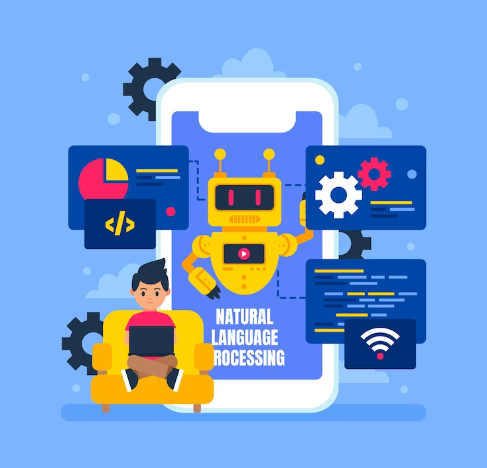
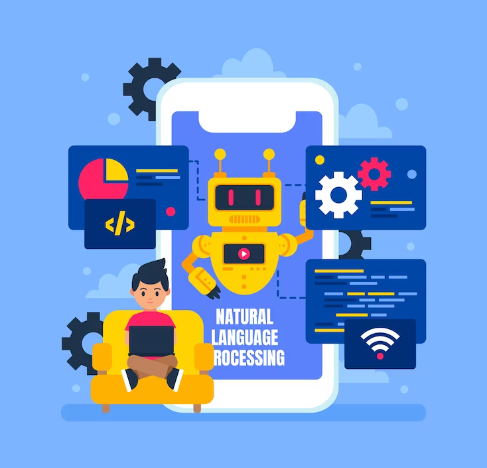
Introduction:
In today’s fast-paced business world, Artificial Intelligence (AI) is becoming increasingly important in helping companies stay competitive. With the power to automate routine tasks, make data-driven decisions, and unlock new opportunities, AI is transforming the way we work and live. But to harness the full potential of AI, you need the right Application Development Company. In this blog post, we will highlight the Top 7 AI Development Companies that can help you transform your business and take advantage of the latest AI trends. So whether you’re looking to improve your customer experience, optimize your operations or drive innovation, these companies have the expertise and resources to help you succeed. Let’s dive in.
AI Development Companies That Can Transform Your Business
Artificial Intelligence (AI) has become a key aspect of modern business operations, helping companies increase productivity, efficiency, and accuracy. If you’re looking to implement AI in your business, then you need the services of an AI Development Company.
These companies specialize in creating software applications that leverage AI to automate various business operations, improve customer experiences, and unlock new revenue streams. By partnering with an AI App Development Company, you can leverage their expertise and experience to help you navigate the complex world of AI development.
However, finding the right AI Development Company can be challenging. You need to find a company with the right skills, experience, and expertise to help you build your AI application. This is where it makes sense to Hire Software Developers or Hire App Developers, depending on your specific needs.

2) Trends To Watch In AI Development For 2023
As we approach the year 2023, the field of AI development is poised for incredible growth and innovation. Here are some of the top trends to watch in this field:
1. Integration of AI with Blockchain: In the near future, we can expect to see the integration of AI with blockchain technology, leading to new forms of decentralized, secure systems. This trend is particularly promising for industries such as finance and healthcare, where security and trust are critical.
2. Continued Growth of Virtual Assistants: Virtual assistants such as Siri, Alexa, and Google Assistant are already becoming commonplace in our lives, but in the coming years, they are set to become even more powerful and versatile. With AI-driven personalization, these assistants will be able to provide more personalized and accurate responses to user queries.
3. Increasing Use of AI in Cybersecurity: As cyber threats continue to evolve, companies are turning to AI to help detect and respond to potential attacks. AI-powered cybersecurity tools are able to analyze large amounts of data and identify potential threats in real-time, allowing companies to respond quickly and effectively.
4. AI Development Companies: In the coming years, the demand for AI development companies is only going to increase. Companies of all sizes and industries are recognizing the importance of AI in their business operations and are looking to hire software developers and app developers with AI expertise.

3) Google
As one of the world’s largest tech companies, Google has been at the forefront of AI development for years. Its extensive resources and commitment to research have made it a leader in the industry, with a wide range of applications and tools for businesses of all sizes.
One area in which Google has made significant progress is in natural language processing (NLP), which involves understanding and interpreting human language. Its cloud-based API, Google Cloud Natural Language, provides a powerful and accurate tool for businesses to analyze and understand customer feedback, product reviews, and more.
Google is also an application development company, and it offers a variety of AI-powered tools and solutions that businesses can use to create custom applications and software. Its AutoML technology allows users to build and train machine learning models without any programming knowledge, making it more accessible to businesses that don’t have a team of data scientists.
In addition to its AI-focused products, Google is investing in cutting-edge research in areas like machine learning, computer vision, and robotics. With its resources and commitment to innovation, Google is definitely one of the companies to watch in the AI development space.
Also Watch: Unlocking the Power of AI: Real-World Examples of Business Success
4) Amazon Web Services
Amazon Web Services (AWS) is a subsidiary of Amazon that provides on-demand cloud computing services to individuals, companies, and governments. As a leading Artificial Intelligence App Development Company, AWS has been investing heavily in machine learning and AI technologies over the years. Its machine learning platform, Amazon SageMaker, offers a complete toolkit for building, training, and deploying machine learning models.
AWS has been powering several businesses and organizations with its AI and ML services, enabling them to improve efficiency, accuracy, and decision-making capabilities. For instance, Dow Jones has been using AWS’s machine-learning capabilities to create news articles with a human-like tone and style. Also, Formula One uses AWS to analyze data from its races to improve car performance and enhance fan experiences.
AWS has been expanding its offerings and recently launched Amazon Kendra, an AI-powered enterprise search service that uses natural language processing and machine learning to find the most relevant information. Additionally, the company has also been collaborating with other AI development companies and research institutes to advance the field of AI further.
Overall, AWS’s AI development services and platforms offer businesses of all sizes and industries a competitive edge, making them a crucial player to watch in the AI industry in the coming years.

5) Facebook
Facebook, the social media giant, is one of the world’s leading Artificial Intelligence App Development Companies. With a vast user base and a wealth of data at its disposal, Facebook is poised to continue its leadership in AI development. One of the key areas where Facebook has been using AI is in the development of its chatbots and virtual assistants. Its Messenger app has more than 1.3 billion monthly active users and has been using AI to offer personalized recommendations and better customer service.
The company has also been exploring the use of AI in areas such as content moderation and facial recognition. In fact, Facebook’s AI-powered algorithms can now recognize faces with 98.25% accuracy, outperforming humans in the task. Facebook has also made significant strides in Natural Language Processing (NLP) technology, which powers its AI-driven chatbots.
If you’re looking to Hire App Developers to create an AI-powered application, Facebook should definitely be on your list. The company offers a range of AI tools, including machine learning libraries, neural network platforms, and chatbot frameworks, which can help you create an AI-powered application in no time. Additionally, Facebook also has a thriving community of developers who are always ready to share their expertise and provide support to new developers.
Conclusion
As we look ahead to the future of AI development, it is clear that these top 7 companies will continue to be major players in the industry. Microsoft, Google, Amazon Web Services, and Facebook have already made significant strides in the field, and we can expect even more exciting developments from them in the coming years. Other innovative AI Development Companies are also emerging and will definitely be making an impact in the industry.
If you are looking to leverage the power of AI for your business, we recommend that you consider partnering with a trusted AI app development company to help you achieve your goals. By working with experts in the field, you can take advantage of the latest trends and technologies to create innovative solutions that drive your business forward.
Remember, the future is bright for AI, and there has never been a better time to start exploring the possibilities. So, if you want to stay ahead of the curve and achieve success in your industry, hire app developers who can build custom AI solutions that are tailored to your unique business needs.

Top 5AI Development Companies To Transform Your Business was originally published in Becoming Human: Artificial Intelligence Magazine on Medium, where people are continuing the conversation by highlighting and responding to this story.
Last Chance! Certified AI Workshops Start in 24 Hours! Don’t Miss Out!
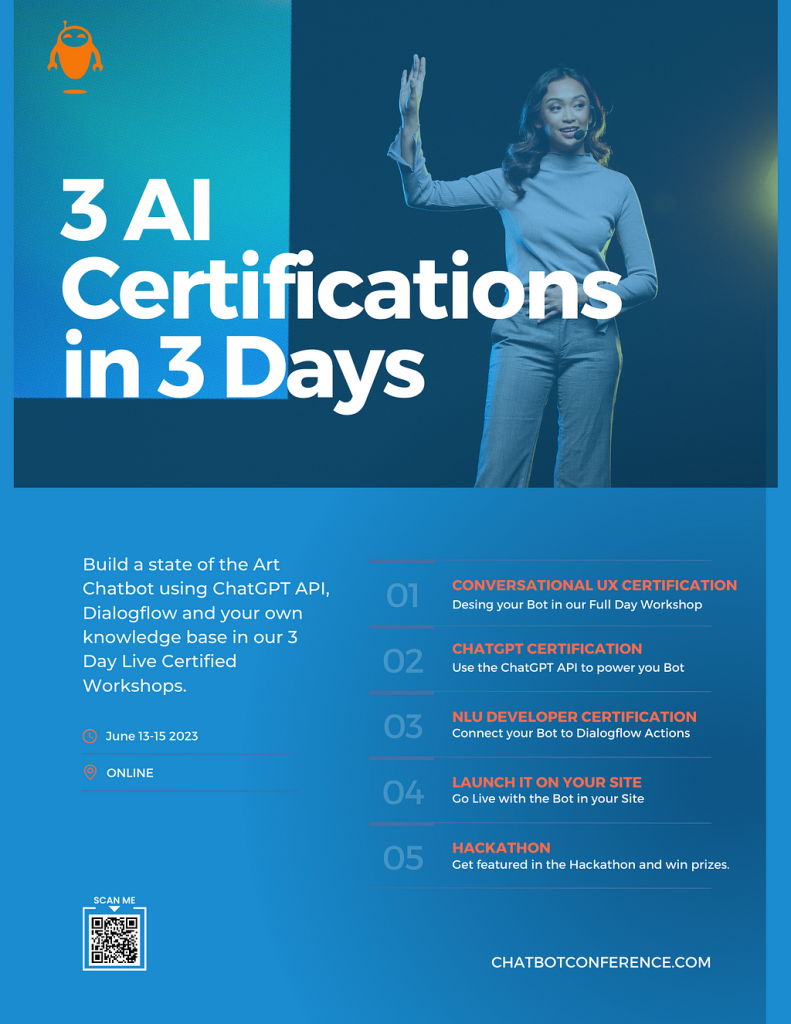

Exciting news! The highly anticipated AI Workshops begin in ~24 hours, and we don’t want you to miss out on this incredible opportunity!
This email serves as a crucial reminder to secure your spot before it’s too late — this is your last chance to purchase tickets!
Here’s what you need to know:
📅 Workshop Start Dates: June 13–15
⏰ Workshop Schedule: 9am to 4pm Pacific Time Zone
📍 Location: ZOOM
🔑 What to Expect: Build an AI chatbot powered by ChatGPT/Bard with the help of experts.
Don’t let this opportunity slip away. Enroll in the AI & Chatbot Certified Workshops today to unlock your AI potential and stay ahead of the curve.
If you have any questions or need assistance with the registration process, please don’t hesitate to reach out to us. We’re here to help ensure a smooth and seamless experience for you.
Get ready to embark on an incredible journey in just 5 days! We can’t wait to welcome you to the AI & Chatbot Certified Workshops and witness your growth in the world of AI.
Cheers!
Stefan

Last Chance! Certified AI Workshops Start in 24 Hours! Don’t Miss Out! was originally published in Becoming Human: Artificial Intelligence Magazine on Medium, where people are continuing the conversation by highlighting and responding to this story.
Flash Sale: Unlock Your AI Potential Today!
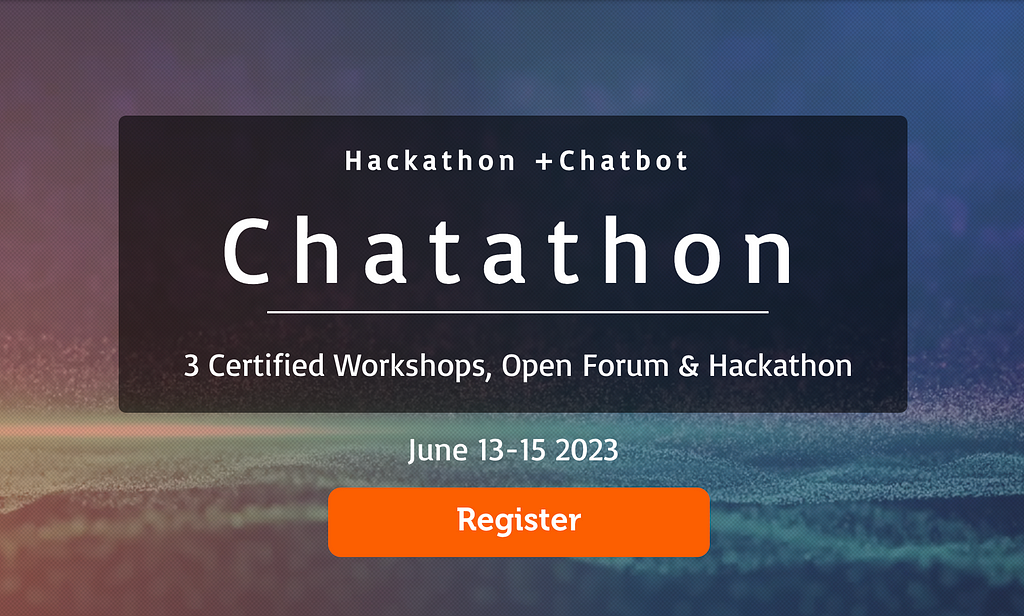

Dear AI Innovators,
Exciting news! Our highly anticipated Flash Sale is now live, offering you an exclusive opportunity to unlock your AI potential like never before.
Don’t miss out on this limited-time offer to supercharge your AI skills and take your development journey to new heights! Here’s why you should dive right in:
- Enhance Your Development Toolkit: Discover the power of design principles and their practical application in solving complex problems. Gain a deep understanding of how design can amplify your development skills and elevate your AI projects.
- Master the Conversational AI Stack: Expand your expertise with the Conversational AI Stack, equipping yourself with invaluable skills in Large Language Models (LLMs), Natural Language Understanding (NLU), Knowledge Bases, and Data. Unleash the true potential of intelligent conversational systems.
- Rapidly Launch MVPs: Learn how marketers and entrepreneurs successfully create and launch Minimum Viable Products (MVPs) at lightning speed. Collaborate seamlessly across teams and accelerate the development cycle, delivering innovative solutions in record time.
But that’s not all!
Companies can also reap substantial benefits from the AI Workshops:
- Explore 5 Cutting-Edge Technologies: In just three days, dive deep into five remarkable technologies: ChatGPT, Bard, Dialogflow, Botcopy, and Voiceflow. Experience hands-on sessions that allow you to assess the true potential of each technology and make informed decisions for your AI initiatives.
- Expert Guidance and Support: Receive personalized assistance directly from the founding teams (Botcopy & Voiceflow) behind these cutting-edge technologies. Benefit from their expertise, industry insights, and best practices, ensuring a seamless learning experience and empowering you to achieve remarkable results.
- Streamline Your AI Investment: Spend your time and resources wisely by rapidly vetting AI technologies. Via our Workshops, you can efficiently assess the suitability of different AI solutions without long months of research and costly investments. Choose the best-fit technology for your organization, driving maximum ROI.
Now is the time to seize this opportunity and embark on your AI journey with confidence. Take advantage of our exclusive Flash Sale before it’s gone:
- Event: Chatathon: AI & Chatbot Certified Workshops
- Discount: Save 25%
- Code: BH
- Expires: Friday, June 9th
To claim your spot and unlock the immense potential of AI, visit [Registration Link] and use the discount code FLASH25 at checkout.
If you have any questions or need further information, our team of experts is here to assist you. Simply reach out, and we’ll guide you every step of the way.
Unlock your AI potential today and join a community of forward-thinking innovators shaping the future of AI!
Best regards,
Stefan

Flash Sale: Unlock Your AI Potential Today! 🚀 was originally published in Becoming Human: Artificial Intelligence Magazine on Medium, where people are continuing the conversation by highlighting and responding to this story.
How to implement Adaptive AI in your business
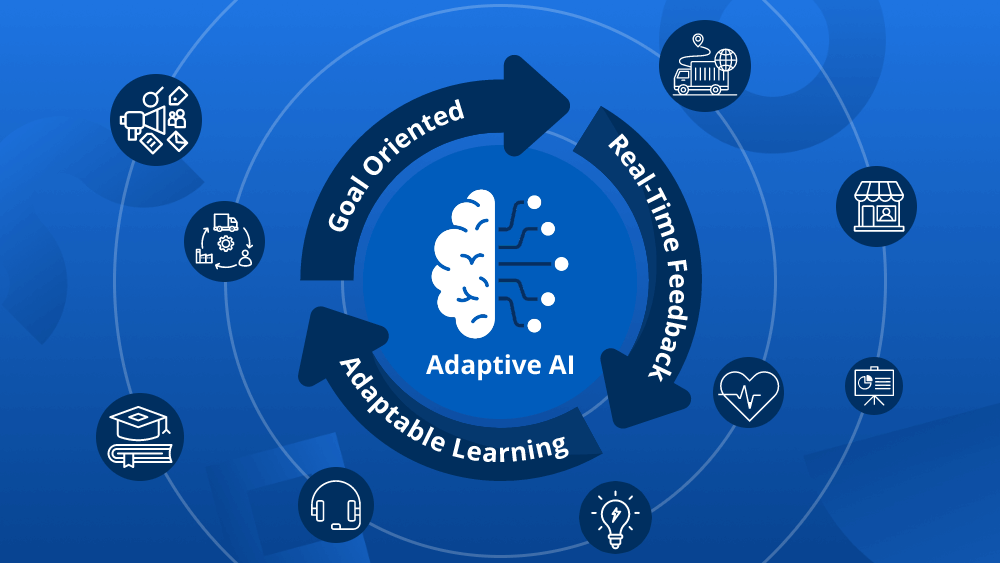
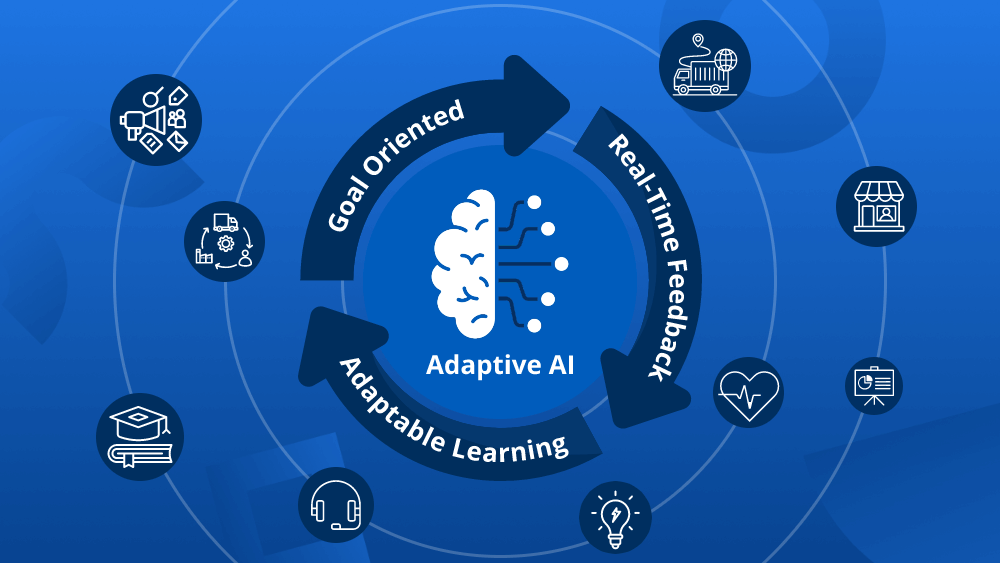
Artificial intelligence has emerged as a powerful technology that can drive substantial transformations in businesses across diverse industries. However, traditional machine learning models have struggled to keep pace with the dynamic nature of our rapidly evolving world, hindering their effectiveness in handling the influx of data generated by the Internet of Things (IoT) and autonomous vehicles. The inability to adapt to new data streams has been a significant limitation of ML models. Fortunately, the emergence of adaptive AI is changing the game. Adaptive AI represents a breakthrough in artificial intelligence by introducing continuous learning capabilities. Adaptive AI models can evolve and adapt in real-time as new data becomes available. This dynamic nature of adaptive AI enables businesses to address the challenges posed by our ever-changing data landscape effectively.
Adaptive AI stands as the next evolutionary progression in artificial intelligence, merging advanced autonomous learning techniques with the capabilities of machine learning. Diverging from previous AI iterations, adaptive AI systems exhibit remarkable adaptability to shifting circumstances. This adaptability is achieved through model retraining and continuous learning from newly obtained information. Adaptive AI steadily enhances performance as time progresses by actively adjusting algorithms, decision-making processes, and actions. This dynamic nature empowers the system to respond more effectively to alterations and obstacles, achieving objectives with heightened efficiency and precision.
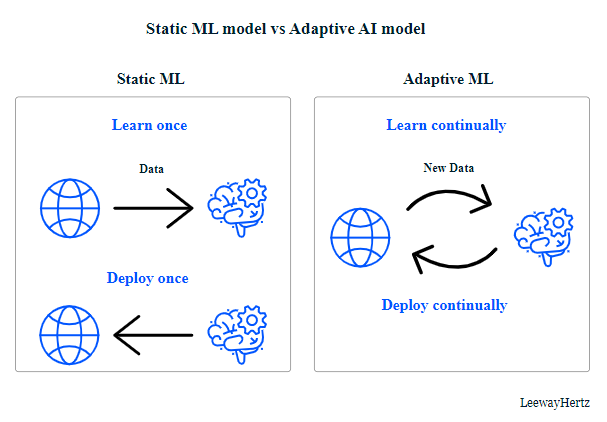
How does Adaptive AI work
Adaptive AI operates on continuous learning (CL), a crucial aspect of achieving AI capabilities. Continuous learning refers to the ability of a model to learn autonomously and adapt to new data as it becomes available in real-time. It mimics the human capacity to continuously acquire, refine, and transfer knowledge and skills. While traditional machine learning focuses on creating models for production environments, continuous learning allows us to utilize incoming data in the production environment to retrain the model and incorporate new insights. Netflix’s “Up Next” recommender system recommends the next show based on user preferences and must be continually retrained. Continuous learning ensures high accuracy by adapting to changing movie selections, user preferences, and market trends. This saves time by automating adaptability and reducing the need for manual retraining, making it an effective approach for improving model accuracy. Continuous learning in adaptive AI enables models to evolve, increasing accuracy and adaptability to dynamic data. By leveraging new information, adaptive AI models become more adept at achieving goals in changing circumstances, ensuring relevance and value in a dynamic business landscape.
AutoML plays a vital role in the continuous learning of adaptive AI by automating the entire machine-learning pipeline. It eliminates manual intervention, reduces training time and resources, and enhances model accuracy. Implementing AutoML involves user-friendly frameworks, hyperparameter optimization, and open-source algorithms, such as transfer learning in computer vision, which leverages pre-trained models for efficient training and deployment.
In the adaptive AI pipeline, once training is complete, model validation is performed to ensure effective functioning, and the best model is selected for deployment. Monitoring is then incorporated to facilitate feedback loops and connect the pipeline to the data source for continuous learning. By integrating AutoML and monitoring, businesses can automate model selection, deployment, and improvement. This iterative approach ensures accuracy and relevance in dynamic environments, harnessing the full potential of adaptive AI.

Why is adaptive AI critical for business growth?
Adaptive AI drives business growth by combining agent-based modeling and reinforcement learning. This unique combination enables real-time adaptation to changes in the real world, even in production environments. An example is the U.S. Army’s adaptive AI system, acting as a personalized tutor, assessing strengths, optimizing teaching approaches, and measuring progress effectively, transforming learning processes to cater to diverse needs.
The significance of adaptive AI for business growth can be summarized as follows:
Increased Efficiency and Automation: Adaptive AI automates routine tasks and processes, freeing up valuable time for employees and increasing overall operational efficiency.
Improved Decision-making: Adaptive AI provides real-time insights and data-driven decision-making, minimizing the chances of human error and enabling more accurate and informed business decisions.
Personalization and Customization: Adaptive AI models are trained to understand individual customer preferences, allowing businesses to deliver personalized experiences and tailored products or services.
Competitive Advantage: Companies that embrace adaptive AI gain a competitive edge by leveraging its capabilities for increased efficiency, innovation, and adaptability, enabling them to stay ahead of their competitors.
Enhanced Customer Satisfaction: Adaptive AI enables companies to provide faster and more effective customer service, leading to higher customer satisfaction and increased loyalty.
Cost Savings: Automation and improved decision-making driven by adaptive AI can lead to significant cost savings by reducing manual efforts and optimizing resource allocation.
Improved Risk Management: Adaptive AI can analyze data and predict potential risks, enabling businesses to identify and mitigate potential issues proactively, minimizing risks and improving overall risk management.
Adaptive Use cases
Adaptive AI, with its ability to continuously learn and adapt in real time, offers various use cases across various industries. Here are some notable examples:
Personalized marketing: Adaptive AI can analyze customer data, preferences, and behavior to provide highly personalized recommendations, offers, and experiences. This can be applied in e-commerce, entertainment streaming platforms, personalized marketing campaigns, and targeted advertising.
Fraud detection and cybersecurity: Adaptive AI can continuously analyze patterns and anomalies in real-time data streams to detect fraudulent activities and enhance cybersecurity measures. It can identify suspicious behavior, protect against cyber threats, and prevent potential financial, banking, and online transaction breaches.
Healthcare and medical diagnosis: Adaptive AI can analyze large volumes of patient data, medical records, and diagnostic imaging to provide accurate and timely medical diagnoses. It can aid in the early detection of diseases, optimize treatment plans, and improve patient outcomes.
Supply chain optimization: Adaptive AI can analyze real-time data on inventory levels, demand fluctuations, transportation logistics, and market trends to optimize supply chain operations. It can predict demand patterns, automate inventory management, and streamline logistics processes.
Smart manufacturing: Adaptive AI can optimize manufacturing processes by continuously analyzing production data, detecting anomalies, and predicting equipment failures. It enables predictive maintenance, reduces downtime, and improves overall operational efficiency.
Autonomous vehicles and transportation: Adaptive AI plays a crucial role in autonomous vehicles, allowing them to adapt to changing road conditions, traffic patterns, and potential hazards. It enhances safety, navigation, and overall performance in self-driving cars and intelligent transportation systems.
Energy management and sustainability: Adaptive AI can optimize energy usage, analyze consumption patterns, and recommend energy-saving strategies for buildings and smart grids. It helps reduce energy waste, improve efficiency, and support sustainable practices.
Financial Analysis and Trading: Adaptive AI can analyze market trends, financial data, and news to provide real-time insights for investment decisions and algorithmic trading. It enhances portfolio management, risk assessment, and trading strategies.
Conclusion
In conclusion, adaptive AI represents a significant advancement in artificial intelligence, offering remarkable capabilities that enable it to learn, adapt, and optimize strategies in response to real-world conditions. With its ability to dynamically adjust algorithms, decision-making processes, and actions, adaptive AI holds great promise across various industries.
By adopting adaptive AI, companies gain a clear competitive edge in the market. They can deliver faster and more effective services, enhancing customer satisfaction, loyalty, and retention. Adaptive AI’s automation and optimization capabilities also drive cost savings by eliminating repetitive tasks and optimizing resource allocation. The transformative potential of adaptive AI extends to decision-making processes, allowing businesses to make more accurate and efficient decisions. By embracing adaptive AI and tapping into its immense potential, businesses can unlock their full capabilities and effectively navigate future possibilities.

How to implement Adaptive AI in your business was originally published in Becoming Human: Artificial Intelligence Magazine on Medium, where people are continuing the conversation by highlighting and responding to this story.
Hello world!
Welcome to WordPress. This is your first post. Edit or delete it, then start writing!